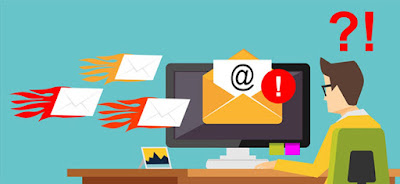WHAT IS EMAIL BOMBARDMENT?


Technology makes life easier for us. We just have to see how mobile phones have become an indispensable device in our day to day. However, we must be attentive to its use, because cybercriminals adapt to these advances with new techniques. One of the most recent is smishing, do you know what it is and how to detect it?
What
is smishing: SMS + phishing?
The smishing is the use of methods of deception through SMS
or text messaging for mobile user's personal information and making fraudulent
use of it. The difference from phishing is the means by which the scam is done;
in phishing it is through e-mail and in smishing it is done with SMS. It is not
a new phenomenon, because it first appeared in 2008, but now it has increased
thanks to the use of messaging applications such as WhatsApp.
The phishing, the smishing and vishing are three types of
widespread fraud. The criminals pretend to be another person, so that the
victim shares with them passwords or card details. Learn to identify them with
this video and protect yourself!
What
are the most common forms of smishing?
Generally, the objective of these messages is to obtain
confidential information, such as passwords or bank details, but sometimes also
to sell non-existent products or "infect" the mobile. To achieve
this, they send an SMS to the user with an irresistible promotion, the
possibility of winning a prize or simply a notice from a courier company or a
bank.
If the message is clicked, the user is directed to a
fraudulent web page that either imitates the original to steal their bank
details or passwords, either contains malicious code to install malware, or
tricks the user into installing one malicious application that will collect and
send confidential information to third parties.
It is also common to send messages asking to call a
telephone number with a special rate or to subscribe to a premium SMS service
that involves an additional cost
How
can you avoid fraud?
Here are few ways in which you can avoid fraud
Ø Be
wary of messages from unknown and misspelled senders, in English or that appear
to be a poor translation from English. Also of the promotions or messages of
companies or services that you have not used previously.
Ø Never
provide the information the message asks for when it comes to personal data.
Ø Do not
click on the links, or download attachments.
Ø Block
the text messages that you consider spam to not receive them anymore.
Ø Verify
the sender, as they often impersonate a known contact or company. If you have
questions about the message, do a quick search on the internet with its content
to discover if it is a scam or write to your contact through another channel
(an email, another messaging app) or call them to confirm that the message is
theirs.
Ø You
should also avoid storing passwords or banking information unencrypted on your
phone, such as in a contact or in the notes app.
Ø Customize
the security options, with secure passwords and double verification systems,
both for mobile phones and electronic banking.
Ø Remember
that the bank will never ask you to provide your access codes or your card
details via SMS.
Ø Using an
updated version of good antivirus
that will help you in stop leakage of your information on internet and keep you
safe.
What
can you do if you are a victim of smishing?
If, despite taking all the precautions, you think that you
have been the victim of a fraudulent message, the first thing you should do is
contact the financial institution to block the operation.
Second, you must change the password to access electronic
banking or the information you have provided. And, above all, you must report
the fraud to the Police, Civil Guard or in the courts, providing the relevant evidence.
Remember, if you get a message like “Congratulations,
you've been awarded a car. To get the prize, send an SMS to this number” or “Dear
customer, your visa card has been blocked for your safety. To unblock it, visit
this website and complete the steps”, be suspicious!
Always be attentive of these types of messages which will
flash on your PC screen or mobile screen.
Comments
Post a Comment